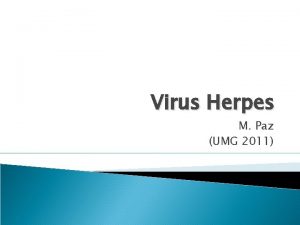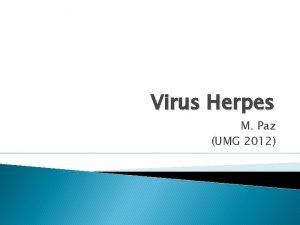Human herpes virus type 6 a lymphotropic virus




- Slides: 4

Human herpes virus type 6: a lymphotropic virus and the single • commonest cause of hospital visits in infants with fever. The cause of roseola. Human herpesvirus type 7: • Epidemiology: • -first demonstrated in 1990 from peripheral blood mononuclear cells of a s yet to be defined. PATHOGENESIS: • Very similar to HHV-6; it is a lymphotropic virus that infect CD 4 T cells and • encode genes allowing it to invade the immune system. CLINICAL FEATURES: • 1 - Generally asymptomatic. Probably causes similar fever and rash • syndromes to HHV-6. 2 - IT may be a cofactor for symptomatic CMV disease in renal transplant • recipients.

Human herpesvirus type 8: A herpesvirus associated with several human neoplasms, including Kaposi stleman disease. THE VIRUS: A gamma-herpesvirus(like EBV), first identified in KS tissue from patients infected with HIV. Epidemiology: 1 -In 1980, clusters of KS amongst homosexual men contributed to the recognition of HIV. It has also seen in renal transplant recepients. HHV-8 has been identified in lesions from all forms of KS. 2 -Over 95%of HIV-associated KS cases are in homosexual men, in whom it is HIV non-sexually. 3 -Epidemiological studies suggests a sexual route of HHV-8 transmission, but other means of transmission are not clear. HHV-8 DNA has been detected in the semen and saliva of HIV-infected patients with KS, and not healthy controls.

CLINICAL FEATURES OF HERPESVIRUSES-TYPE 8: 1 -Primary infection: may be associated with fever and rash in children, and new onset lymphadenopathy has been described in HIV-negative homosexual men undergoing HHV-8 seroconversion. Fever, splenomegaly, pancytopenia, and rapid-onset KS has been described in immunocompromised patients. 2 -KS: four epidemiological types: classic, endemic. HIVssociated, transplant- associated). and appear on skin, mucous membranes and viscera(lung, and biliary tract particularly). Lesions are highly vascular and nodular(o. 5 cm-2 cm in diameter). Violacious or brown/black in pigmented skin. Visceral disease may involve any organ(e. g. GI can bleed, pulmonaryeffusions). Lymphedema may follow regional lymph node infilteration. Endemic KS is slow growing and has little prognostic significance. In AIDS patients with KS , the health impact of the lesion is generally of less importance than opportunistic infections. • •

3 -Primary effusion lymphoma(PEL): an aggressive B-cell lymphoma seen in AIDS patients, with predilection for a body cavities, presents as lymphomatous effusions, arising predominantly in the pleural, pericardial and peritoneal cavities. 4 -Castlemans disease: an uncommon lymphoproliferative disorders, first described in 1950. Localized(Unicentric , UCD) FORMS ARE BENIGN AND MAY BE CURED BY SURGICAL EXCISION. Multicentric castleman disease(MCD) is associated with HIV, and is aggressive and is often fatal. HHV-8 is associated with less than 50% of HIV-negative MCD and 100% of HIV-positive MCD. DIAGNOSIS: 1 -diagnosis of KS is clinical and confirmed by biopsy. 2 -Lesion biopsy is required for the diagnosis of PEL and Castleman disease. is of limited clinical utility. 4 -PCR for HHV-8 is of little benefit in the diagnosis of KS BECAUSE VIREMIA IS NOT UNIVERSAL WHILE IT IS SO USEFUL IN THE DIAGNOSIS OF MCD, because patients with active disease is viremic and quantification of HHV-8 IS used to track response to treatment. • •







